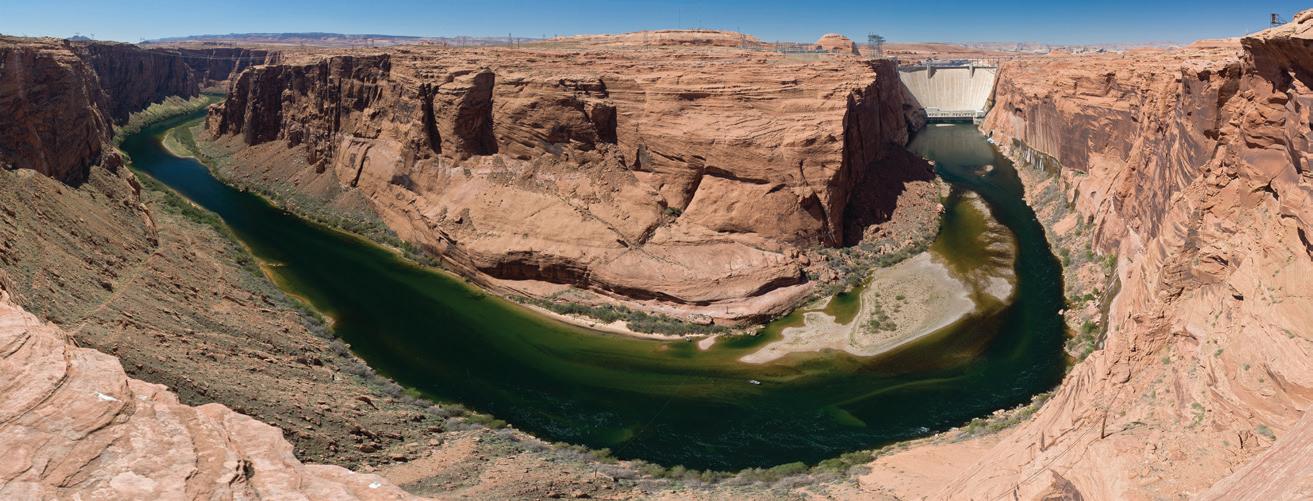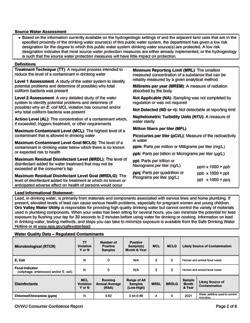BEHIND METER THE
ORO VALLEY WATER UTILITY NEWSLETTER SUMMER 2023
A MESSAGE FROM OUR DIRECTOR
Welcome to our Summer issue of “Behind the Meter”. In addition to managing our water resources to ensure our community’s long-lasting sustainability, the Water Utility is also responsible for ensuring that your drinking water is safe. For more than 20 years the Utility has produced annual water quality reports that demonstrate the successful implementation of the federal regulations set by the Environmental Protection Agency (EPA) and enforced by the Arizona Department of Environmental Quality (ADEQ).
Peter Abraham, P.E. Water Utility Director
Each year, the Utility collects hundreds of water samples from 15 point of entry sites, including groundwater wells, reservoirs, and pumping stations. Additionally, the Utility also samples from 58 sampling stations that are specifically located to represent the water quality delivered to the customers throughout the water distribution system.
Every three years, water samples are taken from 50 private residences within the water service area and are tested for lead and copper. The Utility provides all water quality testing results to the ADEQ and works closely with the agency to ensure all local, state and federal standards are met.
Our community’s drinking water comes from two sources of supply. Approximately 65 percent comes from groundwater pumped from municipal wells located within our service area and the remaining 35 percent comes from the Colorado River by way of the Central Arizona Project (CAP) water canal.

Our community is fortunate that our water supplies are of such high quality that the only source of treatment required of our water is a small amount of chlorine that is injected at our groundwater well production sites. Maintaining a small amount of chlorine residual in our water distribution system ensures that our drinking water system is free of harmful coliform and E. coli bacteria. During 2022, all drinking water samples collected and analyzed, tested negative for these contaminants. This is a direct result of the Utility’s successful disinfection program, system monitoring and a robust maintenance program.
For additional water quality information, please see the links to our annual water quality report provided in this newsletter. In closing, thanks to the continued support from our Town’s leadership, and the community, you can expect the continued long-term delivery of a safe and reliable water supply.
Looking forward,
Peter Abraham
Peter A. Abraham, P.E. | Water Utility Director

11000 N LA CAÑADA DRIVE | 520-229-5000 | OVWATER@OROVALLEYAZ.GOV | WWW.OROVALLEYAZ.GOV
GET TO KNOW YOUR WATER NUMBERS

Those who live in Oro Valley have a pretty good sense about the important role water plays in our lives every day. The community’s commitment to water conservation is evident. In the past year, 64-89% of our residential customers fell within our lowest level of consumption depending upon the season. Not surprisingly, our summer temperatures drive water use during this time and can increase consumption substantially. How can you find a balance between saving water and beating the heat? Being more water aware can make big impacts on conservation and your monthly bill regardless of season. Read more to find out how.
Being average can be a good thing and saves money on your water bill. The average water use for the most common sized meter (5/8”) is about 7,500 gallons per month.
Customers pay the lowest price per 1,000 gallons when they use up to 7,000 gallons. See our rates and fees at orovalleyaz.gov.
For every degree above our average daily temperature, water use increases by about 3 gallons per day per person which can add up to an additional 1,000 gallons or more per month.
Summertime breaks mean kids may be home more. Families may be more active and can lead to more showers and even extra laundry! Resist the temptation to take those extra showers. Reducing shower times by just 1 or 2 minutes can save water as well as washing full loads when doing laundry and loading the dishwasher.
Our customers commonly put 50% or more of their total water use outdoors. Plants are an important part of our yard and a connection to wildlife.
• Choose low water use or native plants that need less frequent watering and limit water thirsty plants such as grass.
• Irrigation leaks, overwatering and timer scheduling errors add up quickly on your bill. Monitor your daily water use online and receive automated leak alerts using WaterSmart at orovalley.watersmart.com
• Got a pool? Pools on average use about 2,000 gallons/ month due to evaporation and back flushing but can use more in the summer and less in the winter. Make sure your pool’s autofill is working correctly. If your pool demands water 24/7 or you have unusual water use, investigate for leaks in your pool and pool equipment.
Scan the QR code or visit smarthomewaterguide.org and click on Outdoor Visual Leak Inspection to learn about the bucket test.
• Are you tired of your pool? Removal is an option. For general information on the process and cost savings calculator, go to poolremovalhelp.org
YOUR ANNUAL WATER QUALITY REPORT IS NOW AVAILABLE ONLINE
Each year the Oro Valley Water Utility provides customers with an annual water quality report. This report is known as the Consumer Confidence Report and describes how our water quality compares to established federal and state drinking water standards. We encourage you to review this report as it provides important details about the source and quality of the drinking water delivered to your community in 2022.
Please visit us online to view or print your Consumer Confidence Report at:
https://www.orovalleyaz.gov/ovccr2022.pdf
Oro Valley Consumer Confidence Report

https://www.orovalleyaz.gov/csccr2022.pdf
Countryside Consumer Confidence Report
To request a mailed copy, please contact Customer Service at 229-5000.
11000 N LA CAÑADA DRIVE | 520-229-5000 | OVWATER@OROVALLEYAZ.GOV | WWW.OROVALLEYAZ.GOV BEHIND THE METER | ORO VALLEY WATER UTILITY NEWSLETTER SUMMER 2023
OVWU Consumer Confidence Report Page 1 of 5 Public Water System ID Number Public Water System Name AZ04-10-164 Oro Valley Water Utility Contact Name and Title Phone Number E-mail Address Adam Pence, Lead Operator 520-229-5042 apence@orovalleyaz.gov You may also offer comments and suggestions at public meetings. Unless otherwise posted, the Oro Valley Town Council and Oro Valley Water Utility Commission hold regular meetings at 11000 N. La Cañada Drive, Oro Valley, AZ 85737 as follows: Oro Valley Town Council Meetings Oro Valley Water Utility Commission Meetings 1 and 3rd Wednesday of every month 6:00 p.m. 2 Monday of every month 5:00 p.m. Town Council Chambe s or via Zoom Hopi Conference Room or via Zoom Drinking Water Sources The sources of drinking water (both tap and bottled water) include rivers, lakes, streams, ponds, reservoirs, springs, and wells. As water travels over the surface of the land or through the ground, it dissolves naturally-occurring minerals, and in some cases, radioactive material, and can pick up substances resulting from the presence of animals or from human activity. In order to ensure that tap water is safe to drink, EPA prescribes regulations which limit the amount of certain contaminants in water provided by public water systems. Food and Drug Administration (FDA) regulations establish limits for contaminants in bottled water which must provide the same protection for public health. Our water source(s): Groundwater taken from the Canada del Oro Wash basin. In addition, 35 percent of the water delivered in 2022 was Central Arizona Project (CAP) water blended with groundwater through Tucson Water system connections. Please see most recent Tucson Water Quality Reports at https://www.orovalleyaz.gov/twccr2022.pdf Drinking Water Contaminants Microbial Contaminants Such as viruses and bacteria that may come from sewage treatment plants, septic systems, agricultural livestock operations, and wildlife Inorganic Contaminants Such as salts and metals that can be naturally-occurring or result from urban stormwater runoff, industrial or domestic wastewater discharges, oil and gas production, mining, or farming Pesticides and Herbicides Such as agriculture, urban storm water runoff, and residential uses that may come from a variety of sources Organic Chemical Contaminants Such as synthetic and volatile organic chemicals, which are by-products of industrial processes and petroleum production, and also may come from gas stations, urban storm water runoff, and septic systems. Radioactive Contaminants That can be naturally occurring or be the result of oil and gas production and mining activities. Vulnerable Population Drinking water, including bottled water, may reasonably be expected to contain at least small amounts of some contaminants. The presence of contaminants does not necessarily indicate that water poses a health risk. Some people may be more vulnerable to contaminants in drinking water than the general population. Immuno-compromised persons such as persons with canc undergoing chemotherapy, persons who have undergone organ transplants, people with HIV-AIDS or other immune system disorders, some elderly, and infants can be particularly at risk from infections. These people should seek advice about drinking water from their health care providers. For more information about contaminants and potential health effects, or to receive a copy of the U.S. Environmental Protection Agency (EPA) and the U.S. Centers for Disease Control (CDC) guidelines on appropriate means to lessen the risk of infection by Cryptosporidium and microbiological contaminants call the EPA Safe Drinking Water Hotline at 1-800426-4791. Oro Valley Water Utility Consumer Confidence Report for Calendar Year 2022 Este informe contiene informactión muy importante sobre el aqua usted bebe. Tradúscalo hable con alguien que lo entienda bien.





